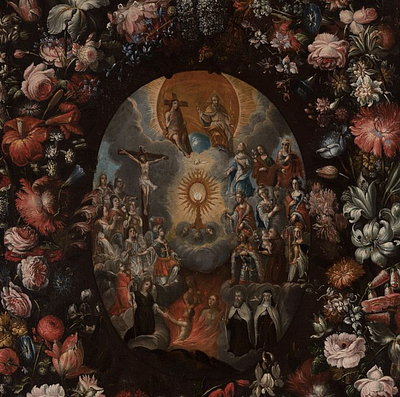Italian school of the XVIII century, workshop of LUCA GIORDANO (Naples, 1634 - 1705). "Virgin of the milk with the Child". Oil on canvas. Re-tinted.
Lot 124
About Seller
Setdart Auction House
Carrer Aragó 346
Barcelona
Spain
Setdart Subastas was born in 2004 and is currently the first online art auction in Spain with solidity, prestige and reliability guaranteed by our more than 60,000 users. Setdart has a young, dynamic and enterprising team ready to successfully manage the purchase and sale of art works through custom...Read more
Estimate:
EUR€8,000 - EUR€10,000
$8,602.15 - $10,752.69
Absentee vs Live bid
Two ways to bid:
- Leave a max absentee bid and the platform will bid on your behalf up to your maximum bid during the live auction.
- Bid live during the auction and your bids will be submitted real-time to the auctioneer.
Bid Increments
| Price | Bid Increment |
|---|---|
| EUR€0 | EUR€10 |
| EUR€200 | EUR€25 |
| EUR€500 | EUR€50 |
| EUR€1,000 | EUR€100 |
| EUR€3,000 | EUR€200 |
| EUR€5,000 | EUR€500 |
| EUR€10,000 | EUR€1,000 |
| EUR€20,000 | EUR€2,000 |
| EUR€50,000 | EUR€5,000 |
About Auction
By Setdart Auction House
Jul 14, 2021
Set Reminder
2021-07-14 06:30:00
2021-07-14 06:30:00
America/New_York
Bidsquare
Bidsquare : OLD MASTERS
https://www.bidsquare.com/auctions/setdart-auction-house/old-masters-7202
Setdart Auction House sofia@setdart.com
Setdart Auction House sofia@setdart.com
- Lot Description
Italian school of the XVIII century, workshop of LUCA GIORDANO (Naples, 1634 - 1705). "Virgin of the milk with the Child". Oil on canvas. Re-tinted. Size: 53 x 42 cm; 59 x 48 cm (frame). The artist presents us with a scene of great warmth, where several of the most relevant religious themes of Christianity harmonize. At first we could think that it is the representation of the Holy Family, as the figure of St. Joseph is on the left side of the composition, however, the presence of the ox on the far right tells us about the birth of the Child in Bethlehem, as well as the breaking of glory that dazzles some peasants in the last plane. However, the main theme is the representation of the Virgin of the Milk or of the Good Milk, also known as the Nourishing Virgin or wet nurse, Virgin of the Rest or of the Good Rest, Virgin of Bethlehem or of the grotto of Bethlehem; it is an invocation and an iconography of the Virgin Mary, in which she is represented in the act of breastfeeding the Child Jesus. This representation has had various developments in sacred art, such as painting, sculpture and the particular iconography of the Orthodox Church.The representation of the Virgin suckling the baby Jesus is mentioned by Pope Gregory the Great, a mosaic with this representation probably dating from the twelfth century is found on the facade of the Basilica of Santa Maria in Trastevere, although a few other examples from the early Middle Ages still survive. It is considered that this invocation may be a syncretism of the mother-goddesses, in particular of the goddess Isis suckling Horus, and probably the earliest images appeared in Coptic art. The Milk Grotto is a place in Bethlehem, very close to the Basilica of the Nativity, where tradition says that the Virgin suckled the Child, and a drop spilled on a rock, which changed its color, becoming white. Because of this, stones from the grotto (made of calcium carbonate) were considered relics in the early centuries because, when diluted in water, the water took on the appearance of milk. The sanctuary erected in this place is used by women who ask the Virgin to improve the quality of their mother's milk. A theme within the Christian hagiography linked to the nursing Virgin is that of Lactatio Bernardi, according to which the Virgin appeared in a dream to a monk and, by giving him some of her milk, granted him a miraculous gift. Due to its technical and aesthetic characteristics, this work can be related to the artistic production of Luca Giordano, who enjoyed great popularity during his lifetime, both in his native Italy and in our country. However, after his death his work was often reproached for its rapid execution, opposed to the Greco-Latin aesthetics. It is believed that he was formed in the environment of Ribera, whose style he followed at first. However, he soon traveled to Rome and Venice, where he studied Veronese, whose influence has been felt ever since in his work. This trip was key to the maturation of his style, as well as the influences of other artists such as Mattia Preti, Rubens, Bernini and, above all, Pietro da Cortona. At the end of the 1670s Giordano began his great mural decorations (Montecassino and San Gregorio Armeno in Naples), which were followed from 1682 by other projects, including the mural paintings in the gallery and library of the Palazzo Medici Ricardi in Florence. In 1692 he was called to Madrid to carry out mural works in the monastery of El Escorial, where he worked from 1692 to 1694. Later he also painted the office and bedroom of Charles II in the Royal Palace of Aranjuez, and after these he undertook the paintings of the Casón del Buen Retiro (ca. 1697), the sacristy of the cathedral of Toledo (1698), the royal chapel of the Alcazar and San Antonio de los Portugueses (1699).
- Shipping Info
-
In-house shipping available. Please inquire at admin@setdart.com.
-
- Buyer's Premium



 EUR
EUR CAD
CAD AUD
AUD GBP
GBP MXN
MXN HKD
HKD CNY
CNY MYR
MYR SEK
SEK SGD
SGD CHF
CHF THB
THB















